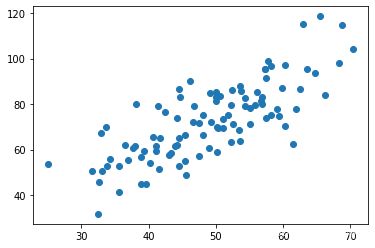文章目录
1.手工梯度下降法
import numpy as np
import matplotlib.pyplot as plt
%matplotlib inline
#载入数据
data=np.genfromtxt("/root/jupyter_projects/data/fangjia1.csv",delimiter=',')
#x_data=data[0:,0]#分离data数据,取所有行第0列
x_data=data[:,0]#等价于上边那行
y_data=data[:,1]
plt.scatter(x_data,y_data)#绘制散点图
plt.show()

#学习率learning rate
lr=0.0001
#截距
theta_0=0
#斜率
theta_1=0
#最大迭代次数
epochs=50
J ( θ 0 , θ 1 ) = 1 2 m ∑ i = 1 m ( ( ^ y ( i ) ) ? y ( i ) ) 2 = 1 2 m ∑ i = 1 m ( h θ ( x ( i ) ) ? y ( i ) ) 2 J(\theta_{0},\theta_{1})=\frac{1}{2m}\sum_{i=1}^{m}{(\hat(y^{(i)})-y^{(i)})^{2}}=\frac{1}{2m}\sum_{i=1}^{m}{(h_{\theta}(x^{^{(i)}})-y^{(i)})^{2}} J(θ0?,θ1?)=2m1?∑i=1m?((^?y(i))?y(i))2=2m1?∑i=1m?(hθ?(x(i))?y(i))2
#最小二乘法
#计算代价函数
def compute_error(theta_0,theta_1,x_data,y_data):
totalError=0
for i in range(0,len(x_data)):
totalError+=(theta_1*x_data[i]+theta_0-y_data[i])**2
totalError
return totalError/float(2*len(x_data))
对代价函数求偏导:
?
?
θ
j
J
(
θ
0
,
θ
1
)
=
?
?
θ
j
1
2
m
∑
i
=
1
m
(
h
θ
(
x
(
i
)
)
?
y
(
i
)
)
2
\frac{\partial }{\partial \theta_j}J(\theta_0,\theta_1)=\frac{\partial}{\partial \theta_j}\frac{1}{2m}\sum_{i=1}^{m}({h_\theta(x^{(i)})-y^{(i)})^2}
?θj???J(θ0?,θ1?)=?θj???2m1?∑i=1m?(hθ?(x(i))?y(i))2
θ 0 : j = 0 \theta_0:j=0 θ0?:j=0: ? ? θ 0 J ( θ 0 , θ 1 ) = 1 m ∑ i = 1 m ( h θ ( x ( i ) ) ? y ( i ) ) \frac{\partial }{\partial \theta_0}J(\theta_0,\theta_1)=\frac{1}{m}\sum_{i=1}^{m}({h_\theta(x^{(i)})-y^{(i)})} ?θ0???J(θ0?,θ1?)=m1?∑i=1m?(hθ?(x(i))?y(i))
θ 1 : j = 1 \theta_1:j=1 θ1?:j=1: ? ? θ 1 J ( θ 0 , θ 1 ) = 1 m ∑ i = 1 m ( h θ ( x ( i ) ) ? y ( i ) ) ? x ( i ) \frac{\partial }{\partial \theta_1}J(\theta_0,\theta_1)=\frac{1}{m}\sum_{i=1}^{m}({h_\theta(x^{(i)})-y^{(i)})*x^{(i)}} ?θ1???J(θ0?,θ1?)=m1?∑i=1m?(hθ?(x(i))?y(i))?x(i)
应用梯度下降法修改不断当前值
θ 0 \theta_0 θ0?= θ 0 ? α ? ? ? θ 0 J ( θ 0 , θ 1 ) = 1 m ∑ i = 1 m ( h θ ( x ( i ) ) ? y ( i ) ) \theta_0-\alpha*\frac{\partial }{\partial \theta_0}J(\theta_0,\theta_1)=\frac{1}{m}\sum_{i=1}^{m}({h_\theta(x^{(i)})-y^{(i)})} θ0??α??θ0???J(θ0?,θ1?)=m1?∑i=1m?(hθ?(x(i))?y(i))
θ 1 \theta_1 θ1?= θ 1 ? α ? ? ? θ 0 J ( θ 0 , θ 1 ) = 1 m ∑ i = 1 m ( h θ ( x ( i ) ) ? y ( i ) ) ? x ( i ) \theta_1-\alpha*\frac{\partial }{\partial \theta_0}J(\theta_0,\theta_1)=\frac{1}{m}\sum_{i=1}^{m}({h_\theta(x^{(i)})-y^{(i)})*x^{(i)}} θ1??α??θ0???J(θ0?,θ1?)=m1?∑i=1m?(hθ?(x(i))?y(i))?x(i)
#梯度下降
def gradient_descent_runner(x_data,y_data,theta_0,theta_1,lr,epochs):
m=len(x_data)
#达到最大迭代次数后停止
for i in range(epochs):
theta_0_grad=0
theta_1_grad=0#求梯度该变量
for j in range(0,len(x_data)):
theta_0_grad+=(1/m)*((theta_1*x_data[j]+theta_0)-y_data[j])
theta_1_grad+=(1/m)*((theta_1*x_data[j]+theta_0)-y_data[j])*x_data[j]
theta_0=theta_0-(theta_0_grad*lr)#同时更新参数模型
theta_1=theta_1-(theta_1_grad*lr)
#没迭代5次更新一次图像
if i%5==0:
print("epochs:",i)
plt.scatter(x_data,y_data)
plt.plot(x_data,theta_1*x_data+theta_0,'r')
plt.show()
return theta_0,theta_1
print("starting theta_0={0},theta_1={1},error={2}".format(theta_0,theta_1,compute_error(theta_0,theta_1,x_data,y_data)))
print('running')
theta_0,theta_1=gradient_descent_runner(x_data,y_data,theta_0,theta_1,lr,epochs)
print("end{0} theta_0={1},theta_1={2},error={3}".format(epochs,theta_0,theta_1,compute_error(theta_0,theta_1,x_data,y_data)))
#画图
# plt.scatter(x_data,y_data)
# plt.plot(x_data,theta_1*x_data+theta_0,'r')
# plt.show()
starting theta_0=0,theta_1=0,error=2782.5539172416056
running
epochs: 0

epochs: 10

epochs: 20
![[外链图片转存失败,源站可能有防盗链机制,建议将图片保存下来直接上传(img-2JG7rjll-1641220068004)(output_7_9.png)]](https://img-blog.csdnimg.cn/08aadcf4a1c84e328e56c8d6ea835929.png?x-oss-process=image/watermark,type_d3F5LXplbmhlaQ,shadow_50,text_Q1NETiBA5piv5b-Y55Sf5ZWK,size_12,color_FFFFFF,t_70,g_se,x_16)
epochs: 30

epochs: 40
![[外链图片转存失败,源站可能有防盗链机制,建议将图片保存下来直接上传(img-S1bQzLt5-1641220068008)(output_7_17.png)]](https://img-blog.csdnimg.cn/2b1b6af72a574defad0b2a6a8d6511a5.png?x-oss-process=image/watermark,type_d3F5LXplbmhlaQ,shadow_50,text_Q1NETiBA5piv5b-Y55Sf5ZWK,size_12,color_FFFFFF,t_70,g_se,x_16)
epochs: 45

end50 theta_0=0.030569950649287983,theta_1=1.4788903781318357,error=56.32488184238028
2.sklearn实现
import numpy as np
import matplotlib.pyplot as plt
from sklearn.linear_model import LinearRegression
%matplotlib inline
#载入数据
data=np.genfromtxt("/root/jupyter_projects/data/fangjia1.csv",delimiter=',')
#x_data=data[0:,0]#分离data数据,取所有行第0列
x_data=data[:,0]#等价于上边那行
y_data=data[:,1]
plt.scatter(x_data,y_data)#绘制散点图
plt.show()
print(x_data.shape)
#x_data

(100,)
x_data=data[:,0,np.newaxis]
print(x_data.shape)#将x_data 转换为一个矩阵
y_data=data[:,1,np.newaxis]
#x_data
(100, 1)
#创建并拟合模型
model=LinearRegression()
theta=model.fit(x_data,y_data)
#画图
plt.scatter(x_data,y_data)
plt.plot(x_data,model.predict(x_data),'r')
plt.show()
print(theta)
print(model.coef_)#theta_0
print(model.intercept_)#theta_1
```